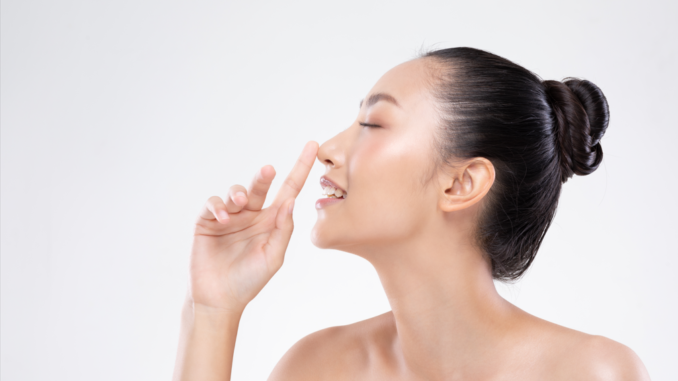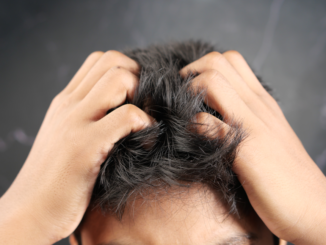
If you have bumps inside the nose, that are reddish and raised and look like pimples or acne, they could be ingrown hairs. This is a common occurrence especially if they appear after shaving inside the nose. Mostly, these ingrown hairs inside a person’s nose occur due to wrong trimming, or use of the wrong nasal hair removal technique. At times, when you cut naturally curly hair very close, it will have a sharpened end that tends to pierce the skin, thus causing an ingrown hair. Ingrown hair within the nose can be unpleasant, so if you don’t deal with it correctly, it can bring about an infection.
It is also possible for ingrown hair in nose to occur when you have the hair growing sideways underneath the skin. If this is the case, then you cannot blame the cutting technique as the cause. If sebum along with dead skin cells accumulate and clog the follicles, it can make the hair to grow underneath the skin in sideways. A person having ingrown hair may experience irritation and inflammation, that contribute to bumps forming within the affected nasal area.
While ingrown hairs aren’t a serious thing, sometimes, they can be painful and itchy. They also cause unsightly bumps along with a rash. If there is an infection, you could have severe symptoms. Men are mostly likely to have ingrown hairs, especially those having long or lots of nasal hair and cut it often. Though rare, women may also experience this problem.

Table of Contents
How to Identify Ingrown Hair Within the Nose
You may want to know how ingrown hair looks like ,and the kind of symptoms you are likely to have. Because there is irritation occurring from ingrown hair, you expect to have bumps that look like pimples. If there is an infection, you will see redness in the inside and outside. Painful sores may occur in rare occasions if the infections remain untreated.
In addition to the red bumps, the area of the ingrown hair will feel itchy and irritating. You are likely to scratch the nostrils, however, this is discouraged because it encourages infections like staphylococcus bacterial infection. When you look at the mirror, you can see the bump with hair trapped in it. The hair may also grow horizontally underneath the skin of the nose. If the bumps discharge pus, it indicates an infection.
What Causes Ingrown Hair in Nose?
There are various reasons as to why ingrown hair occurs in the nose.
Inappropriate shaving
When the hair in nose is cut too short, it develops a sharp edge that makes it burrow back into the individual’s skin. An individual should not shave their nose hair too short. The tools used to remove hair like blades can cause irritation to the skin resulting in blockage of hair follicles. When this happens, it makes the hair to grow sideways in the skin. The problem may also arise due to use of tweezers to pluck nasal hair. If you want to remove hair in nose, you can consider using a pair of scissors having rounded ends.
Clogging of hair follicles
Having clogged follicles can cause hair to grow back into the nasal skin. There are different things that cause the skin pores to clog; they include hormonal imbalances and other factors that influence sebum production. When there is hormonal imbalances occurring in an individual’s body, it causes an increase in sebum production.
Sebum is a skin lubricating oil that helps keep it moisturized. Hormonal imbalances can occur during puberty, pregnancy, in periods and at menopause. Taking medications like birth control pills can induce hormonal changes that cause the pores to block. Foods that step up the insulin amounts in the blood may also trigger hormonal imbalances hence clogging of follicles. The accumulation of dead skin cells in the skin may also clog pores.
Infections
Having infections caused by bacteria and virus can contribute to the problem. These infections cause blisters to form that upon healing leave behind scabs. The scabs can make the hair to start growing beneath an individual’s nasal skin.
Debris in nose
When a person has congested nose, it may cause debris and scabs that form nasal hair to grow into the individual’s skin. The debris may also make it difficult for the hair growth under the skin to come out. This means that the hair will tend to grow sideways under the skin.
Ingrown Hair in Nose Tip and Outside the Nose
It is likely to have ingrown hair inside the nose or on the tip of the nose. While it can happen, these are rare cases because the areas outside the nose don’t usually have coarse hair like you would find with the nostrils. The hair strands found outside the nose are fine and hardly ingrown. People also don’t remove the fine hair strands outside the nose. On the nose tip, it’s also not common to have ingrown hairs. Many people don’t shave the nose tip because there is no much coarse hair.
Treatment of ingrown nose hair
Most cases of ingrown hair will heal on their own, however, if they are severe, they may require treatment to prevent scarring or worsening of the condition. The treatment largely depends on what could be causing ingrown hair. If it’s an infection, use of antivirals and anti bacterial medications can help. For mild cases of ingrown hairs, they can deal with by gently scrubbing the skin.
A dermatologist may prescribe steroids to help relieve swelling. To help get rid of dead skin cells, retinoids are administered. These medications also help reduce skin pigmentation likely to arise due to the ingrown hair scarring.
There are natural products that can help with the treatment of an affected skin by ingrown hairs, especially after the removal. You can apply apple cider vinegar, honey, aloe vera, baking soda, or ginger after you remove the ingrown hair to reduce infections.
Authoritative Clinical References
Pseudofolliculitis Corporis -https://www.ncbi.nlm.nih.gov/pmc/articles/PMC4387696/




Be the first to comment